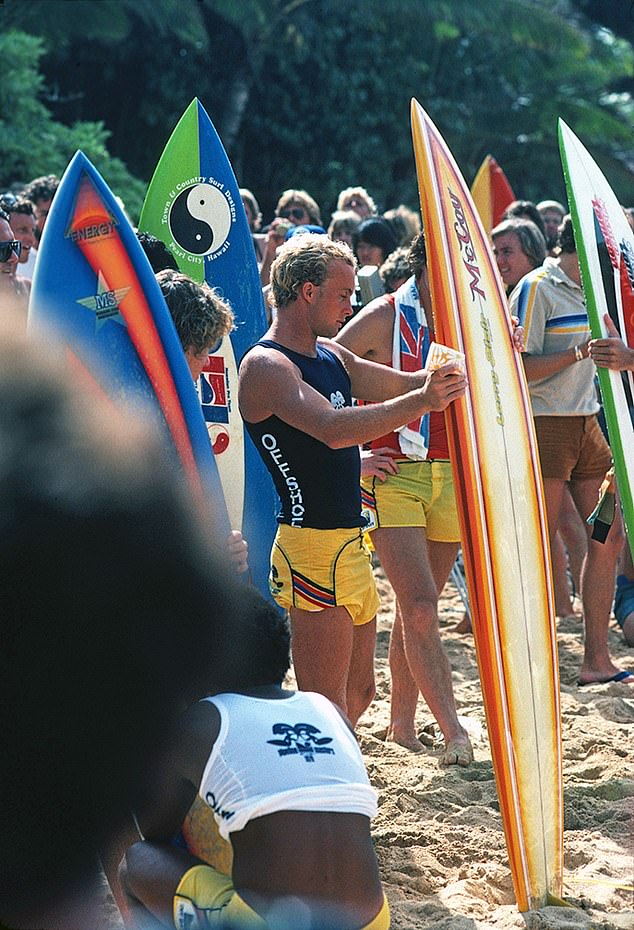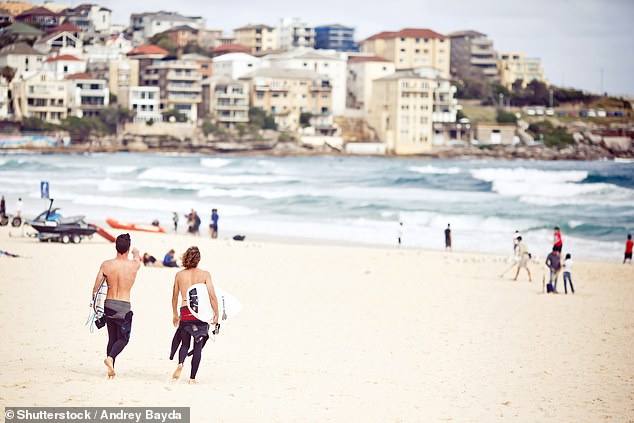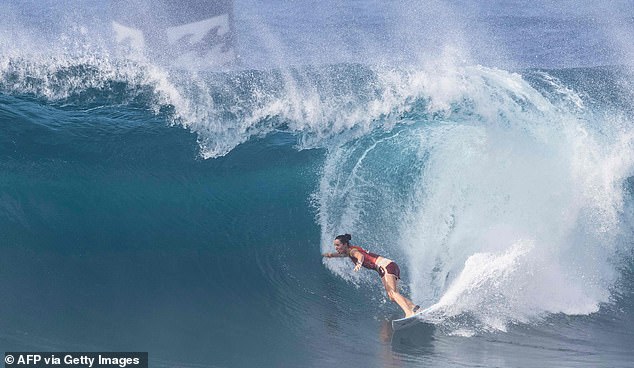My dad’s toes were cut off one by one…and then his body dissolved in acid by gangsters. After a childhood like that, tackling Hawaii’s infamous Pipeline wave was a walk in the park
How could a cocky, blonde twenty-year-old boy from Australia be on the verge of winning the most prestigious surfing competition in the world: the 1978 Banzai Pipeline Masters in Hawaii?
This grueling competition takes place in ‘one of the most dangerous, snarling bodies of water in the world’, which has killed more surfers than all the other surf spots in the world combined.
The Hawaiians, who had their own world-renowned surfing talent, didn’t like what they saw. They stared at each other as the young, fearless Larry Blair won heat after heat, reached the final – and then had the nerve to win the competition, thanks to what he describes as ‘the extra wobble, which caused him to spend more time in the deepest, dirtiest caves in the tube.”
Reading Larry Blair’s electrifying memoir, brilliantly articulated by his friend and fellow surfer Jeremy Goring (hotelier to the Royal Family), is itself like riding a liquid rollercoaster.
It would be poignant enough if it were simply about how a boy with a surfing obsession became a world champion.
The descriptions of being in a huge wave (“a liquid cathedral”) are both fascinating and terrifying, and Larry’s love affair with surfing makes you understand the addictive magic of the sport.
Reading Larry Blair’s electrifying memoir, brilliantly articulated by his friend and fellow surfer Jeremy Goring (hotelier to the Royal Family), is itself like riding a liquid rollercoaster. Pictured: Larry Blair

At just 19 years old, Larry won the Australian ‘Surfabout’ competition, which earned him a huge cash prize. And the next year he won the Banzai Pipeline Masters in Hawaii
But that’s only half the story. The other half is that Larry’s mother Patricia and his stepfather Frank ‘Baldy’ Blair were two of Australia’s most hardened thieves, and Larry grew up as their well-educated apprentice.
Their childhood home in Sydney ‘looked like Harrods or Saks Fifth Avenue’: full of stolen goods. His parents stayed up all night planning their crimes: how to “liberate” $200,000 worth of goods in their next heist.
Young Larry knew no other lifestyle. His parents dressed him in silk and cashmere. He gratefully accepted the ill-gotten gifts Frank (“a gnarled bundle of scar tissue” he calls “Dad”) gave him – including a seven-foot red spear-shaped surfboard: “To this day, the most beautiful thing I have ‘ever possessed and the only inert object I have ever truly loved.’
At first, Larry describes the criminal underworld he grew up in as a lot of fun: his bubbly mother’s good looks, bubbly openness, ingenuity, and deceit made her particularly good at theft, and she often invited Larry to help her in prison. art of distraction. But the crimes became more brutal.
Frank’s armed gang began targeting banks, and “anywhere you could point a gun at someone.” Then, at the age of twelve, Larry overheard them plotting the biggest armed robbery in Australian history: an armored van with cash.
Frank and his gang surprised the drivers at gunpoint when the door of their van was open during their lunch break and made off with more than half a million dollars in cash. “The most expensive lunch break in the world,” blared the headlines.
After hiding the money in the ceiling of a betting shop, Frank took the family to a Chinese banquet. Then they had to go into hiding in the desert for a while.
Frank comes across as a sympathetic, big-hearted villain. He paid a terrible price. One of his fellow robbers handed him over, and he was hunted down by a gang of even more ruthless criminals known as the Toe-Cutters, who kidnapped him and cut off each of his toes one by one, asking him where he had gone. the loot hidden. Then they killed him and dissolved his body in a vat of acid.

Their childhood home in Sydney ‘looked like Harrods or Saks Fifth Avenue’: full of stolen goods. Pictured: surfers at Bondi Beach in Sydney
From then on, Larry’s mother Patricia became a criminal herself, running an efficient network from her home. When Larry was in his mid-teens, she and her boyfriend John started a scam that diverted welfare payments to fictitious accounts. Larry took part in this. Within a good week, $1,000 could be deposited into his fake account.
But the police spotted them and they had to flee again – this time to Britain, where Patricia joined the British crime network.
Larry didn’t go to Britain. He decided to use his money to buy a ticket to Hawaii, where he came into contact with the global surfing community, from disgruntled viscounts, drug addicts, misfits and refugees like himself.
Upon returning to Australia he was arrested – and released, but the scare that gave him marked the end of his criminal career and the start of his surfing career.
This book’s descriptions of the towering Hawaiian waves are unforgettable: gigantic waves of water crashing into the island’s steep volcanic peaks. The waves reflect the storms that occurred a few days ago 3,500 km further north. A slight restraint of energy at the last moment “creates a final, mighty concentration of power.”
At just 19 years old, Larry won the Australian ‘Surfabout’ competition, which earned him a huge cash prize. And the next year he won the Banzai Pipeline Masters in Hawaii.
World fame went straight to his young head. By his own account, he ‘drank, partied, sh*gged and crashed cars’ across Sydney. No girlfriend could stay with him for long: he was too obsessed with surfing.
There was darkness at the heart of the world of competitive surfing. “Localism,” he explains, “is one of surfing’s ugly secrets.” Larry naively blurted out in a magazine interview that he planned to score five Pipeline Masters victories. That was the catalyst for the local population’s revenge.

Larry didn’t go to Britain. He decided to use his money to buy a ticket to Hawaii, where he came into contact with the global surfing community, from disgruntled viscounts, drug addicts, misfits and refugees like himself. Pictured: Tyler Wright of Australia competing in the Banzai Pipeline in Hawaii
On his third attempt at the Banzai, in 1980, he was chased and chased from the waves by a gang of three or four Hawaiian surfers. “I felt like a seal being hunted by orcas.” He dropped out of the competition.
“That annoying swagger had become my Achilles heel,” he writes. “It had made me a target.” He decided to quit competitive surfing for good. He earned a living from TV advertisements and roles in TV soaps before becoming a chef. He now lives happily in Bali with his wife Nyoman.
As for his mother Patricia, she and her friends planned and executed the most brazen jewel theft in Australian history in 1980: the Goloconda diamond, or ‘Glonda’, which was temporarily on display in a display case at Sydney Town Hall. They posed as diamond cleaners. Once they stole the diamond, they didn’t know what to do with it. To this day it is listed as missing.
Patricia died at the age of 48 from a brain tumor. Mother and son had matched each other in daring. Her theft of the “Glonda,” Larry writes, was “the pinnacle of her crazy, dangerous, hilarious and utterly incomprehensible career. It was ‘her pipeline.’
BOOK OF THE WEEK: THE OUTSIDE, by Larry Blair and Jeremy Goring (Penguin Random House Australia £17.99, 320pp)
